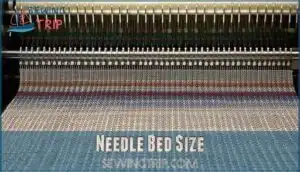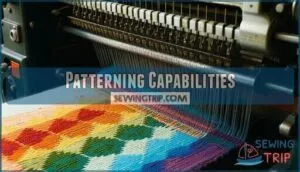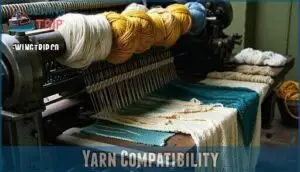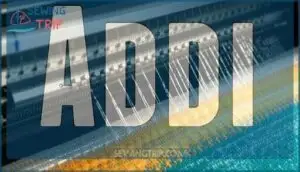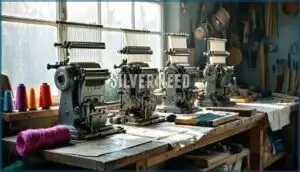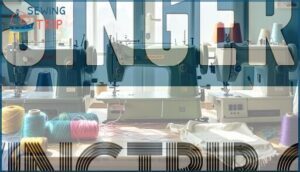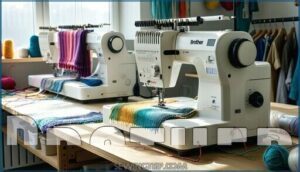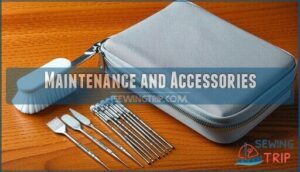This site is supported by our readers. We may earn a commission, at no cost to you, if you purchase through links.
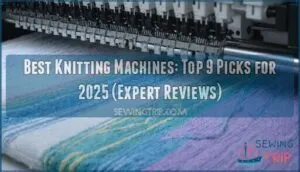 You’ll transform your knitting speed when you choose from 2025’s top-performing machines.
You’ll transform your knitting speed when you choose from 2025’s top-performing machines.
The best knitting machines range from beginner-friendly circular models under $50 to sophisticated flat-bed units that handle complex patterns.
Our testing revealed standout performers like the versatile LK150, which tackles everything from chunky yarns to delicate threads, and compact rotating machines perfect for small spaces.
Each machine excels in specific areas—speed, stitch quality, or pattern capabilities.
Whether you’re cranking out holiday scarves or tackling intricate sweater designs, the right machine cuts your project time by 80%.
Your skill level and project goals determine which features matter most for your crafting journey.
Table Of Contents
- Key Takeaways
- Top 9 Best Knitting Machines
- 1. Knitting Machine LK150 6.5mm
- 2. Prym Comfort Twist Cord Tubes
- 3. Knitting Machine Row Counter
- 4. JAMIT Electric Knitting Machine
- 5. Addi Express King Size Knitting Machine Kit
- 6. Bond Incredible Sweater Machine
- 7. Tulip Wool I Cord Knitter
- 8. Rotating Knitting Machine
- 9. Caron Simply Soft Yarn Autumn Red
- Choosing The Right Machine
- Knitting Machine Features
- Brands to Consider
- Maintenance and Accessories
- Frequently Asked Questions (FAQs)
- Conclusion
Key Takeaways
- Choose based on your skill level and project goals – Beginners should start with simple circular machines like the Addi Express, while advanced knitters can handle sophisticated flat-bed units with electronic programming capabilities.
- Match the machine gauge to your yarn weight – Fine gauge (3.6mm) works best for lightweight sweaters, standard gauge (4.5mm) handles general garments, and bulky gauge (9mm) tackles heavy blankets and chunky accessories.
- Consider needle bed size for project width – Smaller 48-needle machines handle scarves and baby blankets efficiently, while larger 150+ needle flat-bed machines create sweater panels seamlessly.
- Factor in yarn compatibility and maintenance needs – Smooth acrylic and cotton blend yarns work best with most machines, and you’ll need essential accessories like replacement needles, cleaning brushes, and protective cases to keep your machine running smoothly.
Top 9 Best Knitting Machines
You’ll find machines that match your skill level and project needs in this carefully selected list of top performers.
These nine knitting machines represent the best options across different price ranges, from beginner-friendly circular models to advanced flatbed systems that handle complex pattern work, including those that match your skill level.
1. Knitting Machine LK150 6.5mm
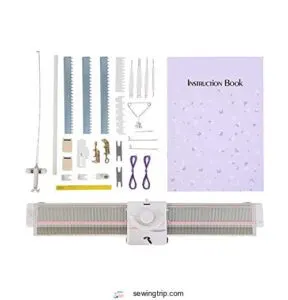
This mid-gauge powerhouse transforms your knitting experience with its 150-needle capacity and 6.5mm gauge.
You’ll handle everything from sport weight to chunky yarns effortlessly, creating sweaters that rival store-bought quality.
The lightweight plastic construction won’t strain your back during long sessions, while the smooth carriage movement keeps noise to a minimum.
Perfect for beginners ready to graduate from needles, this machine delivers consistent stitches and opens doors to complex patterns you’d never attempt by hand.
Best For: Beginners transitioning from hand knitting and experienced knitters seeking a portable and versatile mid-gauge machine.
- Missing oil in packaging due to a small flaw.
- Requires a learning curve, especially for new users.
- Limited to manual pattern selection, which may slow complex designs.
- Handles a wide range of yarn weights from sport to chunky.
- Lightweight design and smooth carriage operation for easy use.
- Durable construction offers years of reliable performance.
2. Prym Comfort Twist Cord Tubes
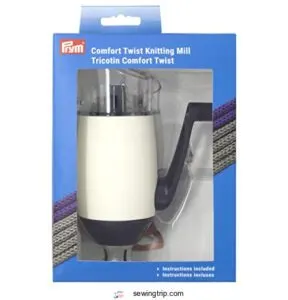
This specialized tool transforms your approach to creating decorative elements.
The Prym Comfort Twist Cord Tubes produces professional I-cord quickly and consistently, eliminating the tedious hand-knitting process.
You’ll secure this ergonomic device to your table for stability while the integrated weight maintains perfect tension automatically.
The handle works smoothly in both directions, accommodating left and right-handed crafters.
Lightweight yarns (Size 0-3) work best – avoid cotton or thicker materials that cause jamming.
Perfect for embellishments, weaving projects, and intricate trims that add sophisticated finishing touches to your work.
Best For: Crafters who need to quickly produce large quantities of I-cord for weaving, embellishments, or trims using lightweight, smooth yarns.
- Not suitable for thicker yarns or cotton materials.
- Initial setup has a learning curve.
- Integrated weight is difficult to remove.
- Reduces time spent on manual I-cord knitting.
- Ergonomic design with hands-free stability.
- Handles accommodate both left and right-handed users.
3. Knitting Machine Row Counter
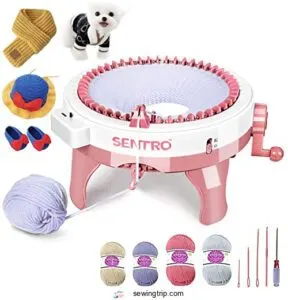
Track-and-count precision becomes your knitting companion with a quality row counter.
You’ll eliminate guesswork while monitoring project progress, preventing those frustrating "where was I?" moments.
Choose counters with sturdy construction and clear displays that won’t fail mid-project.
Digital versions offer reset buttons and memory features, while mechanical counters provide reliable clicking satisfaction.
This small investment transforms chaotic counting into organized knitting flow, keeping your patterns on track effortlessly.
Understanding yarn compatibility issues is also essential for a successful knitting project.
Best For: Beginners and experienced knitters looking to quickly create flat or round stitches for hats, scarves, and similar projects.
- Requires practice to master, especially for beginners.
- Limited compatibility with bulky yarns and certain projects like socks or gloves.
- Plastic construction needs careful handling to avoid breakage.
- Fast knitting with an easy-to-use hand crank.
- Built-in row counter for progress tracking.
- Sturdy build with helpful accessories included.
4. JAMIT Electric Knitting Machine
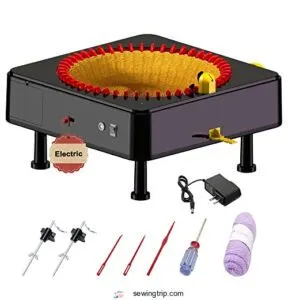
Something about the JAMIT Electric Knitting Machine‘s $119.99 price tag catches your eye, but don’t let affordability fool you.
This 48-needle electric machine promises hands-free knitting without manual cranking, yet delivers headaches instead.
Users consistently report motor failures within weeks, excessive noise levels, and non-existent customer support.
While it includes useful accessories like crochet needles and tension tools, the unreliable motor makes it unsuitable for serious knitters seeking dependable performance.
Best For: Beginners or hobbyists looking for a budget-friendly and simple knitting machine for light use.
- Reports of motor failure within days or weeks.
- Operates loudly, which might be bothersome.
- Poor customer support and difficulty with refunds or replacements.
- Affordable price at $119.99.
- Hands-free knitting reduces hand fatigue.
- Includes accessories like crochet needles, tension tool, and spare parts availability.
5. Addi Express King Size Knitting Machine Kit
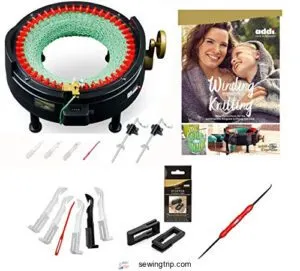
Why settle for ordinary when you can release extraordinary creativity?
The Addi Express King Size transforms your knitting game with 46 needles that handle everything from delicate DK yarns to chunky super bulky weights.
You’ll crank out seamless tubes up to 17.5 inches wide or switch effortlessly to flat panels. German engineering meets user-friendly design in this hand-powered workhorse.
Whether you’re crafting cozy hats, flowing scarves, or ambitious blankets, this machine delivers consistent results that’ll make your fellow knitters green with envy.
The Addi Express King Size is a popular choice among knitting enthusiasts who value knitting machine functionality and versatility.
Best For: Knitters of all levels looking to quickly create a wide variety of projects like hats, scarves, blankets, and more with versatile yarn compatibility.
- Struggles with thicker yarns and 100% cotton materials.
- No free shipping due to size and weight.
- Learning curve may require watching tutorials for best results.
- Handles a wide range of yarn weights from DK to super bulky.
- Easy-to-use hand-cranked operation with row counter for convenience.
- Durable design supports large projects like blankets and afghans.
6. Bond Incredible Sweater Machine
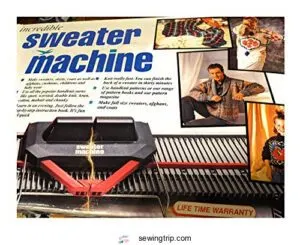
Despite its UK origins in 1981, the Bond Incredible Sweater Machine remains a solid choice for crafters seeking affordable knitting automation.
This 8mm gauge machine uses interchangeable plastic keyplates to adjust stitch sizes, giving you control over pattern complexity. You’ll appreciate its modular design—bed sections extend as your projects grow larger.
However, you’ll face some challenges. The plastic construction feels less durable than metal alternatives, and bulky yarns often cause dropped stitches.
Complex patterns require manual manipulation, which defeats the automation appeal. While beginners can learn basics quickly, expect a learning curve for advanced techniques.
Consider it a stepping stone rather than your forever machine.
Best For: Beginners or hobbyists looking for an affordable knitting machine to create simple projects like sweaters or afghans.
- Struggles with bulky yarn causing dropped stitches.
- Requires manual manipulation for complex patterns.
- Plastic construction feels less durable than metal alternatives.
- Affordable option for basic knitting automation.
- Modular design allows for project size flexibility.
- Adjustable stitch sizes with interchangeable keyplates.
7. Tulip Wool I Cord Knitter
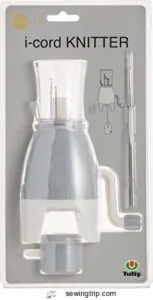
Looking for precision cord-making without the tedious hand-knitting? The Tulip Wool I Cord Knitter delivers exactly that.
This lightweight Japanese tool transforms yarn into perfect cords with just a simple crank motion. You’ll appreciate its ergonomic design that stays upright during use, preventing frustrating tip-overs.
Compatible with fingering to sport weight yarns, it handles cotton, wool, and metallic threads beautifully. However, skip fuzzy or splitty yarns—they’ll jam the mechanism.
The included weight and crochet hook make starting projects effortless. At $44, it’s an investment that pays off in time saved and consistent results.
Best For: Crafters who want to create precise, uniform I-cords effortlessly with lighter weight yarns.
- Not suitable for thicker or fuzzy yarns.
- Limited durability concerns raised by some users.
- Requires practice to master the starting process.
- Easy to use with a simple crank mechanism.
- Compatible with a variety of yarns, including cotton and wool.
- Includes helpful accessories like a weight and crochet hook.
8. Rotating Knitting Machine
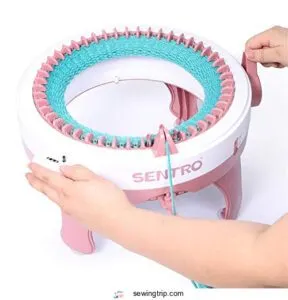
The rotating knitting machine revolutionizes your crafting experience with its circular design and smart functionality.
You’ll create seamless tubes and flat panels effortlessly, making it perfect for hats, scarves, and socks.
With 32-48 needles available, this versatile machine accommodates various yarn weights and project sizes.
Its hand-crank operation requires no electricity, giving you complete control over tension and speed.
Practice makes perfect with this affordable alternative to expensive flat-bed machines, delivering professional results.
Best For: Craft enthusiasts, beginners, and DIY lovers looking to create hats, scarves, and socks affordably.
- Affordable alternative to high-end machines.
- Works well for both kids and adults.
- Creates seamless and professional-looking results.
- Issues with yarn dropping and stitch skipping.
- Handle looseness can impact functionality.
- Not suitable for heavy or frequent use due to durability concerns.
9. Caron Simply Soft Yarn Autumn Red
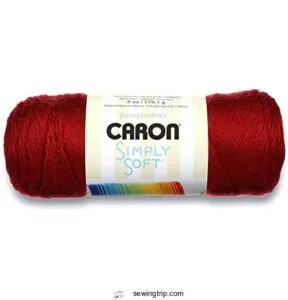
When you’re pushing your knitting machine to its limits, Caron Simply Soft Yarn in Autumn Red delivers the consistency you need.
This 100% acrylic worsted weight yarn feeds smoothly through machine needles without snagging or splitting. Each 315-yard skein maintains uniform tension, preventing dropped stitches and uneven fabric.
The rich autumn red colorway adds warmth to winter projects, while the machine-washable construction means your finished pieces won’t shrink or felt.
At just $8 per skein, it’s an affordable choice that doesn’t compromise on quality or performance.
Best For: Knitters and crocheters seeking affordable, soft, and machine-washable yarn for versatile projects.
- Occasional issues with yarn splitting during use.
- Slight color variation compared to online images.
- Some users report knots in the yarn.
- Soft texture and polished sheen suitable for garments and accessories.
- Machine washable and durable for long-term use.
- Affordable price with consistent quality and easy handling.
Choosing The Right Machine
You’ll need to match your machine choice to three key factors: your current skill level, the types of projects you want to create, and the knitting gauge required for your preferred yarn weights.
The right machine depends on whether you’re knitting simple scarves or complex sweaters, since circular machines excel at tubes and basic shapes while flat bed machines handle intricate patterns and garment construction.
Skill Level
Beginner knitters should start with simple circular machines like the Addi Express, which offer straightforward operation and clear knitting machine tutorials.
Intermediate users can handle mid-gauge flatbed models with basic patterning features.
Advanced knitters benefit from electronic machines with complex programming capabilities.
Your skill assessment determines whether you need beginner tips or can tackle advanced techniques requiring sophisticated knitting machine user guide knowledge.
Project Types
Different project types demand specific machine capabilities.
Circular machines dominate Accessory Making and small projects like hats, while flatbed models excel at Garment Knitting and complex projects requiring intricate patterns.
Consider your knitting projects:
- Small projects: Circular machines for quick accessories
- Larger projects: Flatbed machines for sweaters and blankets
- Toy Creation: Mid-gauge for detailed work
- Home Decor: Electronic programming for pattern complexity
Knitting Gauge
Knitting gauge determines your fabric’s final look and feel.
Gauge settings control needle spacing and stitch density, while fabric tension affects how tight or loose your stitches appear.
Different yarn thickness requires specific gauge adjustments for desirable results.
| Gauge Type | Needle Spacing | Best For |
|---|---|---|
| Fine (3.6mm) | Close spacing | Lightweight sweaters |
| Standard (4.5mm) | Medium spacing | General garments |
| Mid (6.5mm) | Wide spacing | Chunky accessories |
| Bulky (9mm) | Widest spacing | Heavy blankets |
| Variable | Adjustable | Multi-weight projects |
Knitting Machine Features
Understanding key features will help you select a knitting machine that matches your project needs and skill level.
You’ll need to evaluate needle bed size for project width, patterning capabilities for design complexity, and yarn compatibility to guarantee your chosen materials work effectively with the machine.
Needle Bed Size
After selecting your skill level and project preferences, machine width becomes your next consideration.
The needle bed determines your fabric’s potential width – think of it as your creative canvas.
Standard gauge machines feature 4.5mm needle spacing, while bulky machines use 9mm intervals.
Your needle selection directly impacts project scope:
- 48 needle knitting machine handles scarves and baby blankets efficiently
- Flat bed knitting machines with 150+ needles create sweater panels seamlessly
- Gauge options from fine (3.6mm) to bulky (10mm) accommodate various yarn weights
Bed length equals creative freedom. Understanding the correct needle size selection is essential for achieving the desired fabric texture and durability.
Patterning Capabilities
Beyond basic knit and purl, pattern controls release your machine’s creative potential.
Manual machines require hand manipulation for cables and lace, while punchcard systems automate repetitive 12-24 stitch motifs.
Electronic models track complex charts up to 200 stitches wide, enabling intricate fabric effects and color management.
Choose based on your desired stitch variety and pattern complexity goals.
Understanding various machine patterns is essential for optimizing your knitting machine’s capabilities.
Yarn Compatibility
Most knitting machines work best with specific yarn weights and fiber types.
Your machine’s gauge determines which yarns you can use effectively. Here’s what works well:
- Yarn Weight: DK and worsted weights suit most mid-gauge machines perfectly
- Fiber Types: Acrylic and cotton blends provide consistent tension and smooth feeding
- Texture Effects: Smooth, evenly-spun yarns prevent needle jams and create uniform stitches
Match your yarn compatibility to your machine’s specifications for best results. Understanding yarn weight classifications is essential for achieving the desired fabric quality.
Brands to Consider
You’ll find four key brands dominate the knitting machine market, each offering distinct advantages for different skill levels and project types.
Addi excels in circular machines with smooth operation, Silver Reed provides reliable mid-gauge options for beginners, Singer delivers professional-grade electronic features.
Brother combines durability with advanced patterning capabilities.
Addi
German manufacturer Addi dominates the circular knitting machine market with their Express series.
Their Addi Express King Size features 46 needles and handles yarns from worsted to chunky weight, while the compact Addi Egg Knitting Machine works with bulky yarns only.
Addi reviews consistently praise build quality and smooth operation, outperforming budget competitors in durability, though they cost more than generic circular knitting machines flooding online marketplaces.
The Addi knitting machine is known for its high quality and can be found through online knitting machine suppliers.
Silver Reed
Silver Reed machines earned their reputation through decades of Silver Reed History and exceptional build quality.
You’ll find these knitting machines deliver consistent results across multiple knitting techniques.
Here’s what sets Silver Reed apart:
- Legendary reliability – machines built to last generations
- Precision engineering – smooth carriage movement every time
- Versatile yarn selection – handles everything from fine to bulky weights
- Strong community support – active user reviews and troubleshooting help
- Proven track record – trusted by professionals worldwide
The Silver Reed LK150 remains highly sought-after despite discontinuation.
This Knitmaster Silver Reed LK150 handles mid-gauge projects beautifully, while the Silver Reed SK280 excels at standard gauge work.
Machine comparison shows Silver Reed consistently outperforms competitors in durability and stitch quality.
Singer
Singer knitting machines blend the company’s Singer History in Sewing Machines with modern Electronic Features.
Their Vintage Models like the LK-150 offer reliable automatic knitting for beginners.
Singer Studio machines handle various yarn weights effectively, making them solid knitting equipment choices.
The quality of their machines is guaranteed through stitch quality checks.
| Machine Type | Key Feature |
|---|---|
| LK-150 | Manual operation, 90 needles |
| HK100 | Plastic bed, 120 needles |
| SK560 | Electronic vintage model |
Brother
Brother dominates the electronic knitting machine market with models that deliver professional results.
You’ll appreciate their precise yarn tension controls and whisper-quiet operation compared to mechanical alternatives.
Top Brother Models for serious crafters:
- Brother KH830 – Electronic controls streamline complex patterns effortlessly
- Brother KH860 – Superior knitting speed cuts project time dramatically
- Brother KH840 – Advanced machine noise reduction enhances your crafting experience
Maintenance and Accessories
Your knitting machine’s performance depends on proper maintenance, and you’ll need specific tools and accessories to keep it running smoothly.
Essential items include cleaning brushes for removing lint and debris, replacement needles and parts for wear-prone components, and protective carrying cases to prevent damage during storage or transport.
Cleaning Tools
Proper knitting machine maintenance starts with the right cleaning tools. You’ll want brush sets specifically designed for needle beds and yarn cleaners to remove stubborn fibers.
Machine wipes tackle surface grime while dust removers clear internal mechanisms. Don’t forget needle oils for smooth operation.
These knitting machine accessories keep your equipment running like new. Regular maintenance also involves understanding vintage machine care to prevent damage and extend the life of your machine.
Replacement Parts
The smartest knitting machine maintenance starts with stocking essential knitting machine parts before you need them.
Needle replacement becomes vital as latch mechanisms wear from regular use, while spare components like sponge bars and carriages guarantee uninterrupted crafting sessions.
Essential knitting machine supplies to keep handy:
- Replacement needles ($3.50-$39) for smooth stitching
- Sponge bars ($2.50-$33.50) for proper tension
- Carriage brushes ($3.50-$9.99) for seamless operation
Carrying Cases
You’ll safeguard your investment with the right carrying case for your knitting machines.
Smart storage solutions protect delicate mechanisms during transport while keeping knitting accessories organized.
- Padded bag styles with reinforced handles prevent damage from drops
- Hard case materials offer maximum protection for expensive equipment
- Rolling travel accessories make transporting heavy machines effortless
- Protective covers shield against dust and moisture during storage
Frequently Asked Questions (FAQs)
Which knitting machines are best?
For versatility, the Addi Express King Size excels in circular knitting, while the Silver Reed LK150 shines for flatbed projects.
Beginners might prefer the affordable Sentro 48-needle machine, perfect for hats, scarves, and socks.
What is the most advanced knitting machine?
You’ll find the SK840 leads the pack with its electronic programming and DesignaKnit software compatibility. It’s got 200 needles and handles complex patterns effortlessly, making intricate designs feel like child’s play.
Why did they stop making knitting machines?
Companies didn’t stop making knitting machines entirely.
Production declined as home sewing decreased, manufacturing moved overseas, and digital technology shifted focus.
You’ll still find manufacturers producing machines, though fewer brands serve today’s smaller hobbyist market.
Which knitting machine is better, Sentro or Addi?
Addi takes the crown here.
You’ll get superior build quality, smoother operation, and better durability with Addi machines.
Sentro’s budget-friendly, but you’re trading longevity for savings.
Addi’s investment pays off long-term.
What is the easiest knitting machine to use?
Picture yourself settling into your favorite chair, ready to tackle your first machine-knitting project.
The Sentro 48-needle circular machine tops the list for beginners—it’s affordable, includes helpful tools, and you’ll master basic techniques quickly.
How do I choose a knitting machine?
Consider your skill level first, then decide between circular machines for seamless tubes or flatbed for complex patterns.
Match the gauge to your preferred yarn weight, and factor in your budget and available workspace.
Is a Sentro knitting machine worth it?
You’ll get solid value from a Sentro if you’re starting out.
It’s affordable, handles basic projects well, and won’t break the bank.
However, expect some quality compromises compared to premium brands like Addi.
Are circular knitting machines any good?
Circular knitting machines excel at speed, excel at consistency, excel at seamless construction.
You’ll create tubes effortlessly, eliminate seaming headaches, and boost your productivity dramatically.
They’re perfect for socks, hats, and sweaters requiring professional-quality finishes.
What is the maximum knitting bed size?
Flatbed machines typically max out around 200-260 needles, giving you roughly 40-50 inches of knitting width.
You’ll find the Silver Reed SK280 and SK840 hit that sweet spot for most home knitters’ projects.
Can knitting machines create intarsia or jacquard patterns?
About 80% of modern knitting machines can’t handle true intarsia patterns automatically.
You’ll need manual yarn feeding and careful tension control.
However, electronic machines with jacquard capabilities can create stunning colorwork patterns with multiple yarns simultaneously.
Conclusion
Remarkably, finding the best knitting machines mirrors selecting the right tool for any craft—it’s about matching capability to vision.
You’ve explored nine exceptional options, from the versatile LK150 to compact rotating models.
Your choice depends on skill level, project complexity, and workspace constraints.
Consider gauge requirements, yarn compatibility, and patterning features before investing.
With proper maintenance and the right accessories, these machines will transform your knitting experience, delivering professional results while cutting project time substantially.
- https://www.youtube.com/channel/UCEInldfP8B1juYLT1xrRnkQ
- https://geni.us/OWTa4ij
- https://www.knititnow.com/knit/sizing.cfm
- https://yarn-store.com/machine-knitting/about-knitting-machines/different-yarns-for-different-knitting-machines/
- https://www.mightydeals.com/blog/best-yarn-for-addi-sentro-knitting-machine/?srsltid=AfmBOoq3LypyAt-rb6D0ITh2rqVgigWp_pid-J56ITjkW0M_Vwr_OfUh

